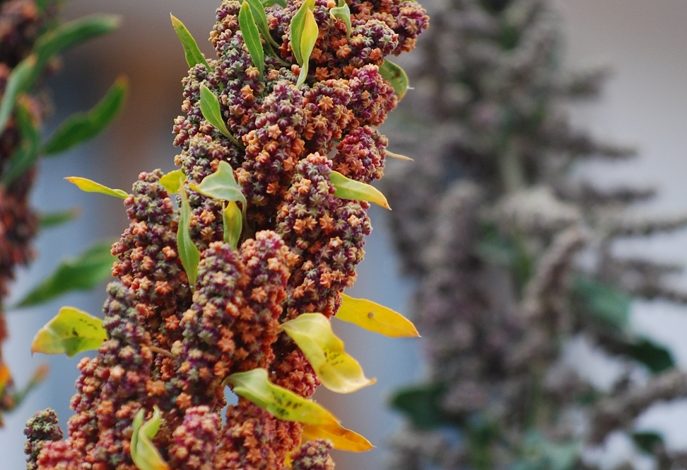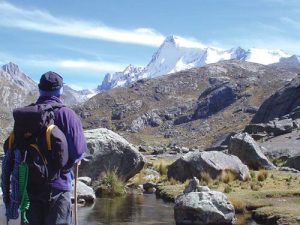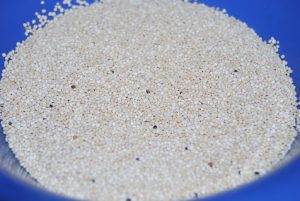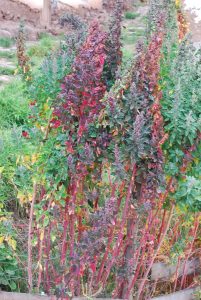Quinoa and Blood Together Make a Community

Where do people come from? Just like now when we talk about the discoveries of early homonids and homonins in Africa by paleontologists, in Inca times people also wondered where people came from. But they often did not talk about people in general, but people of a particular community and place. For example, the Inca ruling caste is said to have come from the caves in Pacariqtambo or from the cliff (Titicaca) on the Island of the Sun.
Place mattered a great deal in a mountainous land where rivers and streams cut their way into the massive uplifts that separate jungle and ocean. The land became a seeming infinity of different nooks and crannies where communities could develop and stories come together.
However, just as there are a few high mountains, generally covered with snow, which stand over this myriad of valleys like shepherds watching sheep, or better llama herders watching their grazing flocks of llamas and alpacas, so too are there stories of individual places and stories of bigger places that draw whole areas together.
In the famous Huarochiri collection of myths that were gathered in Quechua in the early colonial period, at a time when the Spanish were anxious to learn about indigenous ways in order to destroy their Gods and force them into Catholicism, we see both large stories and small ones. But both are local.

The tales narrate a cycle of stories about the great mountain Pariacaca which stands like a sentinel up canyon from the coastal shine of Pachacamac and which received sacrifices from the distant Incas. In this is a difference from the way the natives of Peru thought about origins and the ways our occidental civilization does.

We look for fragments of skeletons that remind us of our own and lay them out in a line from less like us to more. We find them buried in matrices of dirt and stone, like a metaphor of a weighty past and of evolutionary change, both guiding images of our society.
For the Incas and their peers there was no clear separation between land and people such that the one is matrix holding the other, and therefore available for the kinds of metaphors of separation that motivate our ways. Rather the landscape was filled with evidence that it lives. Some people are stone and some flesh, but they are the same in so many ways. That seems to be a ruling idea of the Huarochiri tales.

Communities of people, whether land people (generally called huacas and deserving of human devotion), or more what we think of as people, were divided into two halves. One half was generally the natives and the other was outsiders who came and got involved with the land taking on themselves the obligations of devotion.
The Huarochiri tales have one about a place called Quinoa, like the seed that is increasingly in demand all over the world as a nutritious and valuable food. It is like the biblical mustard seed in that it is tiny when looked at individually, but grows into a towering plant with a massive seed head containing thousands of minuscule seeds. Quinoa is a highland plant appropriate for growth on the upper reaches of the landscape where the tough grass known in Aymara as wichu also grows.
Because of the connection to the place, the Huarochiri tales are concerned with where people emerged. Just as children come from a womb into the world in the process of birth, these stories see people coming into this world–the surface of the earth–in various ways. Some come from cliffs and some from springs.

In the case of Quinoa it says that its original people sprang from the seeds of a wild quinoa plant growing in the upper reaches of Pariacaca. That word wild is significant because it not only is referring to a time before civilization, before the people are wrapped in custom and particularly dance, it also refers to a distant relative whose sons or daughters one can marry. But wild can also refer to one’s ancestors, and potentially to one’s children.
In several places in the Huarochiri tales it talks about the two halves of a community as having that relationship of wildness one to another.
In the case of Quinoa, the manuscript tells blood fell from the sky and that place is called Vichi Cancha, or the enclosure within walls of Vichi as if a multifamily home or a place of devotion. It says from the blood sprang a different people.
Together they made the Checa people (in Aymara the word–the language spoken through much of that area at the time–the word means “true, certain, or real”) who formed part of a series of communities within the domain of the great mountain Pariacaca. The Checa were understood to be the youngest of the peoples, the last born or the last to emerge, and played an important role in the cycles of feasts and devotion to Pariacaca.

The Checa were composed of a native group who were there before Pariacaca came to the area and had his children colonize it, and a newer group of foreigners, the children of Pariacaca.
The plant people were from the quinoa itself as if they grew from the earth, from that tiny seed, and reached for the sky in a heavy spike laden with seed. In contrast, the other people came from the sky as falling blood. They are the opposite of the first, sky down verses ground up, plant versus blood. In the opposition one to another they make a whole.
Though the Huarochiri tales do not say this, it makes sense then that quinoa is served with meat (or some other animal product such as milk and cheese) in order to make a whole like the community of Checa.
Though not a story from Cuzco, the Huarochiri tale of the origin of the Checa people helps us grasp people’s relationship more generally with their food, both that with blood and that coming from tiny seeds, the quinoa. People do not just eat; they eat in ways that fit their stories and their culture.
Reference: The story of quinoa and blood is number 24 in the Huarochiri cycle of tales.




